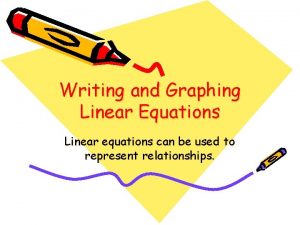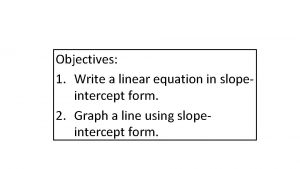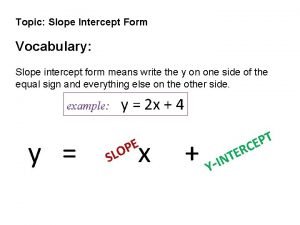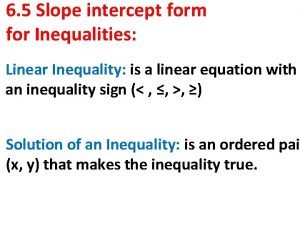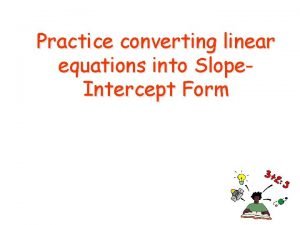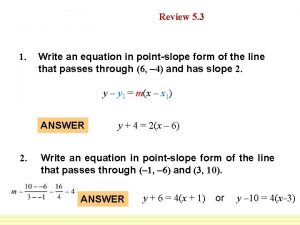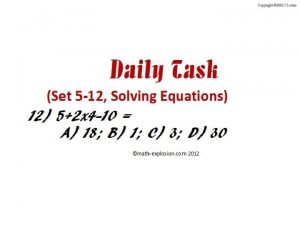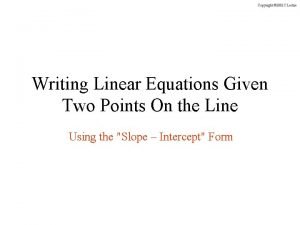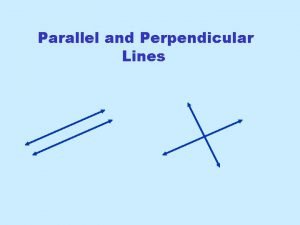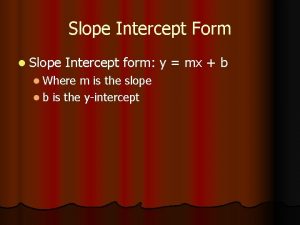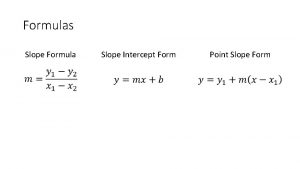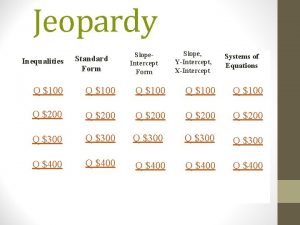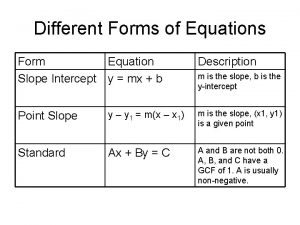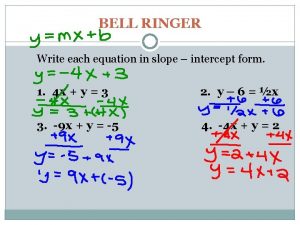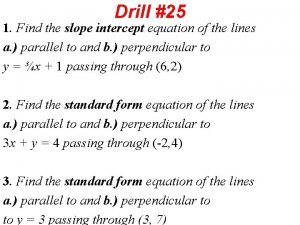Write the equation in slope intercept form then


















- Slides: 18

§ Write the equation in slope- intercept form, then graph the new equation. § State whether it is a function or not and why. 1) 2 x+4 y=8 2) 2 x -y=3

y=1/2 x-2 y=x 2 -3


§ A relationship between variables. § How do we recognize a function? You can identify a function with the vertical line test. For every input there can only be one output.


§ A function is one-to-one if it passes the vertical and horizontal.

We use inverses to solve and interpret equations.

§ Find the inverse of a function § Find the inverse of a relation § Graph a function and it’s inverse § Identify quadratic and square root functions § Understand the relationship between a function and it’s inverse


§ An inverse function is a function that undoes the action of another function. A function g is the inverse of a function f when y=f(x) then x= g(y). § Switch x and y then solve for y. § f-1 is the notation we use for the inverse of f. § Example f(x)=2 x+3 find f-1(x)

§ y=4 x-5 y=1/2 x+4 f(x)=x 2

§ A set of ordered pairs. § { (1, 2), (2, 3), (3, 4), (4, 5) } § A relation is a function when each input is paired with only one output or when every x-value is paired with only one y-value § Examples 1) { (2, 4), (3, 6), (4, 8), (5, 10) } 2) { (1, 1), (2, 2), (2, 3), (4, 5) } 3) { (-3, 5), (-4, -5), (-5, 5), (-6, -5) }

§ An inverse relation is the relation that occurs when the order of the elements are switched in the relation. § Example: Given the relation { (0, 7), (4, -3), (-3, 4), (-2, -2) }, find the inverse relation.


§ A linear function is the inverse of a linear function, a quadratic function is the inverse of a square root function § When you find the inverse of a square root or quadratic function, you must restrict the range so that y>0. § Domain of the relation becomes the range of the inverse and the range of the relation becomes the domain of the inverse. § Check your answer by creating a table and checking that the original function and the inverse function are symmetric about y=x.

f(x)=x+4

f(x)=x 2+1

We will discuss the inverse of exponential and logarithmic functions and use the inverse relationship to solve problems.
 2-2 lesson quiz point slope form
2-2 lesson quiz point slope form Slope intercept example
Slope intercept example Write the slope intercept form of the equation
Write the slope intercept form of the equation How to write and equation in slope intercept form
How to write and equation in slope intercept form How to write an equation in slope intercept form
How to write an equation in slope intercept form Writing equations in slope-intercept form
Writing equations in slope-intercept form How to write an equation in slope intercept form
How to write an equation in slope intercept form Slope inequality
Slope inequality Converting to slope intercept form
Converting to slope intercept form Point-slope form definition geometry
Point-slope form definition geometry Standard to vertex form
Standard to vertex form Standard form of a line quiz
Standard form of a line quiz Rewriting linear equations in slope intercept form
Rewriting linear equations in slope intercept form How to find the y intercept from two points
How to find the y intercept from two points Slope intercept word problems
Slope intercept word problems What is slope intercept form definition
What is slope intercept form definition Slope intercept form ppt
Slope intercept form ppt Perpendicular lines slope intercept form
Perpendicular lines slope intercept form Slope intercept form jeopardy
Slope intercept form jeopardy




